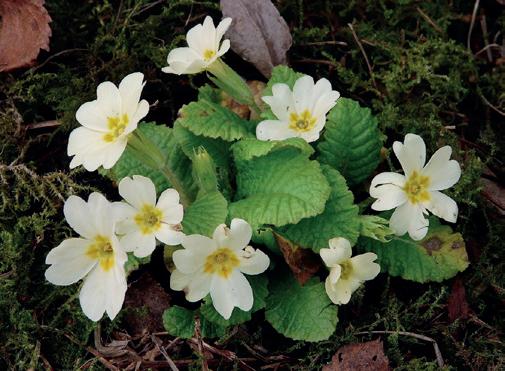



Mud In Your Eye
March - April 2023





Mud In Your Eye
March - April 2023
Encouraging wildlife to your garden
Heavens Above Sedimentary Rock
Welcome to the 62 nd Edition of Mud in Your Eye. In this issue: Hellebores are an early source of nectar

by Patricia L. Cisco
It’s that time of year as we start to move out of winter and the countryside starts to spring to life. ‘Thank goodness’ I am sure many of you are thinking!
There is so much to look forward to and this edition features just some of the things you can look out for, as well as ways of getting involved.
We’d love to hear from you!
Email ranger@eastlothian.gov.uk or follow us...
@ELCrangers @elcrangers
East Lothian Council Countryside Rangers
You don’t need to have a huge pond in your garden to provide water for wildlife. How about sinking an old washing up bowl into the ground to provide birds and hedgehogs emerging from hibernation somewhere to access water? Be careful if you have young children visiting the garden and always put a few rocks or a piece of wood in the bowl to help anything that may accidently fall in, get back out!
This is the time of year that the birds are really getting excited in our gardens! They need plenty of energy for their spring nesting. Make sure if you feed the birds that you keep your feeders clean to avoid passing on diseases or check for mouldy food that might have got wet.
As the wee birds in your garden will be planning and preparing their nests for their own wee ones, why not give them a helping hand by making and hanging
nesting material in an old whisk, or bundle the nesting material together and tie it with a piece of biodegradable garden string. Hang in shrubs and bushes in the garden as the birds will want to keep to the safety of the shrubbery to collect their materials.
You may notice some big bumblebee queens lazily buzzing around low to the ground in March in your garden. They have just woken up from their winter slumber and are on the look-out for a nest site and some early nectar sources to replenish their energy levels.
Why not add some hellebores to your garden to help them out on their quest?
Some hellebores have droopy flower heads so to see their full beauty, tuck a small mirror underneath them so you can get to enjoy them more. Or just get down on your hands and get those knees dirty!
April is officially the start of the bird breeding season, but no one seems to have told the birds that as they often start a bit earlier than that!
Well, if you are trying to raise two or even three broods in a year, you need to get cracking! So, this is not a good time to be cutting back shrubs or getting the hedgecutter out, just leave the plants to grow and protect your birds’ nesting sites.

If you want to have a variety of different bird species to the garden, you need to not only have different types of bird feed but different bird feeders. Robins are ground feeders so only the bravest souls will go for a hanging bird feeder and birds like goldfinches have beaks adapted for collecting wild seeds such as thistle seeds so they like the black niger seeds which you will need a particular niger seed feeder for.
Now this might not be popular with hardened lawn lovers, but, why not leave some dandelions in your garden? They are so important as nectar sources for insects in your garden, early emerging bumblebees and hoverflies will love them. Hoverflies are great pollinators and their larvae are voracious aphid predators, so a win-win species for the garden. So maybe just a few wee dandelions wouldn’t hurt?
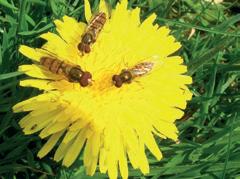
Towards the end of February and into early March, Venus and Jupiter will be side by side (in appearances only, obviously!) reaching their closest on the evening of March 1st. A pair of binoculars will give the best view of them, with Venus being the brightest of the two. On April 11th Venus will appear close to the star cluster known as the Pleiades or Seven Sisters. The seven brightest stars are named after the daughters of the Titan Atlas (the one condemned to hold up the world in Greek mythology). There are in fact around 3000 stars in this bright cluster and you can certainly make out many more than seven through binoculars.
The constellation of Leo is currently easy to find in the night sky. You can find it by searching for the Plough, which is overhead at the moment, and imagine it as a leaking saucepan. The leak would fall directly onto Leo’s back. Leo is one of the few constellations that actually looks like its namesake, resembling a crouching lion. The most obvious part is the lions head and chest, which is formed by a group of stars that is called the sickle, or in more modern terms a backwards questions mark.

In Greek mythology, Leo represents the Numean Lion killed by Heracles (Hercules to the Romans) ion the first of his twelve labours.
The bottom of the sickle is marked by Regulus, the brightest star in Leo. Regulus means ‘little king’ in Latin. In Arabic it is called Alb-al-Asad, which means ’the heart of the lion’. This translates into Latin as Cor Leonis (for all you fans of The Godfather films!). Regulus is in fact a double star. By far the brightest is Regulus A which is a blue coloured star about 3.8 times the mass of our sun. The other is a white dwarf.
Finally, if you are up and about in the early hours of 23rd April, and why wouldn’t you be, you may be lucky enough to catch the peak of the Lyrid meteor shower. This originates from the comet C/1861 G1 Thatcher and is the oldest recorded meteor shower still visible today, being first recorded in 687 BC.

Now is a good time to see two of the brighter planets together in the early evening sky.The constellation of Leo
grained shales and mudstones, through sandstones, up to coarse conglomerates – the latter consisting of gravel sized, or larger, chunks.

A look at some of the cliffs at Gullane will show strata made up of sandstones and mudstones – the differing grain sizes suggest different environments of deposition. As a rule of thumb, finer grained rocks have been formed in slower moving waters than those with coarse grains. This makes sense if you think about current waterways and their beds. Lakes, ponds and slow moving rivers tend to have silty beds, whereas fast flowing upland streams have rocky bottoms.
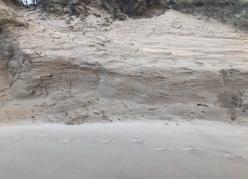

So far in this short series about geology we’ve been looking at some of the big ideas in the science – deep time, plate tectonics etc. Let’s get down to the nitty gritty and have a think about rocks; I mean that’s what geology’s all about, isn’t it?
Rocks are made up of various minerals, such as quartz, feldspars, micas and calcite. Each of these minerals has a fixed chemical composition and atomic structure. In contrast, rock types can vary widely depending on their place and method of formation. So, two samples of quartz will be (effectively) the same, whereas two lumps of sandstone can be very different.
There are all sorts of different rock types, but they can be divided into three main groups – sedimentary, igneous and metamorphic rocks. The first of these is probably the one which most people are familiar with, so let’s start there.
Sedimentary rocks, as the name suggests, are made up of sediments.
These are the bits and pieces that have been eroded from pre-existing rock and moved elsewhere. The mode of transport is very often water, but can also be wind, ice (in the form of glaciers) or just good old fashioned gravity. Eventually the sediment will be deposited somewhere, forming layers, or strata, which build up over time. As this process continues the sediment is compressed and will, in time, harden to form solid rock.
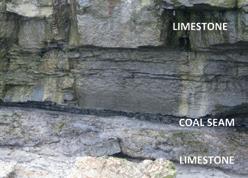
So, what kind of sedimentary rocks can we find in East Lothian?
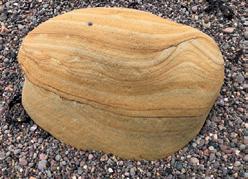
Well, for a start there are all sorts of clastic rocks – these are the ones which consist mainly of rock fragments (or clasts) which have been cemented together. They range from very fine-
Some sedimentary rocks consist mainly of organic remains; these are known as biochemical or biogenic rocks. The shoreline and low cliffs at Whitesands are perfect for viewing these. Many of the strata here are of a light grey rock containing numerous fossils. This is limestone, a rock largely made up of the mineral calcite which is strongly alkaline. In this case the calcite is derived from the shelly remains of ancient sea creatures such as corals. The same cliffs also host thin beds of coal, a rock derived from the plant remains from dense swamp forests which existed over 300 million years ago.
Despite the fact that sedimentary rocks are probably the commonest rock types that we see around us, they only form a thin veneer on the Earth’s surface. Igneous and metamorphic rocks are actually much more prevalent, so we’ll look at some of them next time.


Hug a tree, please, in fact hug more than one, and take in the lumps, bumps, textures and fissures that are home to a myriad of mosses, lichens, fungi and communities of small invertebrates.
The identification of an old Douglas fir is made easy by the recognition of the spider-rich deep vertical fissures that housed some of the fabled mice as they escaped the Californian flood. If you look closely you might spot the latecomers’ rear ends protruding from the Douglas Fir’s cones!

The interest continues underneath where the labours of those bark burrowing beetles that avoided the woodpecker’s searching tongue become apparent when the bark drops off dead and dying trees. Intricate, visually pleasing ‘galleries’ are sculpted on the underside of the bark as the larvae work away. Certain species can be particularly problematic to tree health as their abundance result in the girdling of the tree, terminally disrupting its nutrient flow.
Climate change also may facilitate their spread where warmer conditions allow them to take flight between trees where otherwise lower temperatures would have restricted them.


Just as these rich micro habitats are probed by woodpeckers and mouse-like treecreepers working the trunks for insects, they offer us clues to awkward winter tree ID before their modesty is largely shrouded by the burgeoning spring canopy.
The smooth barked gently twisting forms of old beech trees contrast with the sycamore that gains rich rusty tones and scales as it ages, providing a temporary shelter for caught out bats. Lenticels, tiny holes used by the tree to exchange gases, can expand with age, roughening to the touch and and making obvious these horizontally scattered openings across the shiny trunks of silver birches, and more abundantly, cherries.
If nothing else their increasingly fungi and bug filled bark is more than a bit like us. So go on, give them a hug – we all need one from time to time, so why not the trees too?


 Western Pine Beetle galleries
Douglas Fir cones
Silver Birch Bark
Western Pine Beetle galleries
Douglas Fir cones
Silver Birch Bark
The answers here are the same as the Cryptic Crossword (p17) – so if you get stuck you could always look at those clues! You can also click HERE to complete online. (The solution is on p18)
Across
8. Fish (4)
9/17. Coastal SSSI (10,5)
10. Shape of planets (6)
11. Red pepper (8)
12. Didn’t happen on purpose (8)
14. Baby birds are (6)
16/19. Access officer (4,6)
17. See 9
18. Powdery material (4)
19. See 16
21. Bermuda, for example (8)
23. Helps cut grass (8)
26. High ground (6)
27. Looks after walkways (4,6)
28. Flavours gin (4)
Down
1. Type of coffee (10)
2. * (8)
3. Sheep’s wool (6)
4. Cut (4)
5. Windflowers (8)
6. Snakes (6)
7. Grains of rock (4)
13. Key principle (5)
15. Tyne flows through it (4,6)
17. Organic fertiliser (8)
18. Has a collegiate church near Co’path (8)
20. Japanese entertainer (6)
22. Big lizard (6)
24. May be common, midwife or natterjack (4)
25. Travel on a bus, horse etc (4)
Reminiscent melodies serenade the morning breeze.
Feathered creatures nest with care in cherry blossoms pink and fair.
Perfumed scent of roses flow. Tiny blades of green grass grow.
Misty showers soak the earth, glorious colours come to birth.
Gathering clouds come and go, rain, sun, and vibrant bow.
Dainty petals, fancy flair, dancing in the warm, sweet air.
Violets, yellows, purest white, graceful, gentle, welcomed sight.
Thank you, oh sweet lovely Spring, patiently waiting the charms you bring!
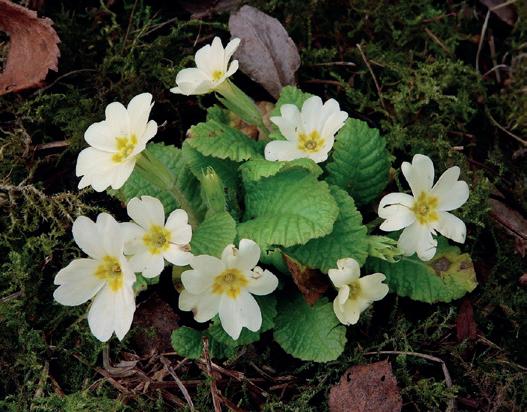
The answers here are the same as the Quickie Crossword (p12) – so if you get stuck you could always look at those clues! You can also click HERE to complete online. (The solution is on p18)
Across
8. Ship gets sailor back to fish (4) 9/17. Yearns to introduce noise back to waterless warped countryside site (10,5)
10. Area of the globe
11. Pepper plant - weirdly I pot mine (8)
12. Stress about primitive instincts - it didn’t happen on purpose (8)
14. Fitted inside stone in need (6) 16/19. He improves access by making corn harvest (4,6)
17. See 9
18. Clean inside Hindu’s temple (4)
19. See 16
21. Change relating to musical instrument (8)
23. Something in better order would cut grass (8)
26. Map in empty underpopulated high ground (6)

27. Pan around election room in the walkway carer (4,6)
28. Is allowed even to flavour gin (4)
Down
1. Concocted conic cuppa coffee (10)
2. Replaces words in bad taste, risky sentences (8)
3. Take (wool?) to the cleaners (6)
4. Cut tail off snipe (4)
5. Windflowers are names one makes up (8)
6. Dreads writhing snakes (6)
7. Courage in under-going rite of passage (4)
13. Key principle of hate networks (5)
15. Tennis - a lot is played in this town (4,6)
17. Blame one’s mixture of fertiliser (8)
18. Grey-ish brown mirror found near Bilsdean (8)
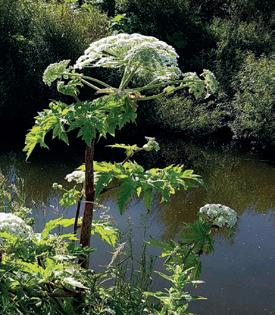
20. Japanese woman - she got involved with a GI (6)
22. Lizard in Guiana? (6)
24. Frog in to a duchess? (4)
25. Travel on horse-back in opposite direction (4)
Volunteer Diary Dates